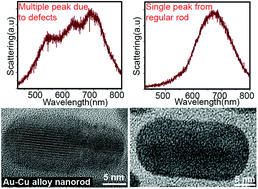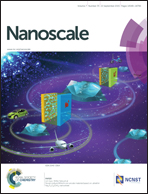Structural defect induced peak splitting in gold–copper bimetallic nanorods during growth by single particle spectroscopy†
Abstract
A single particle level study of bimetallic nanoparticle growth provides valuable information that is usually hidden in ensemble measurements, helping to improve the understanding of a reaction mechanism and overcome the synthetic challenges. In this study, we use single particle spectroscopy to monitor the changes in the scattering spectra of Au–Cu alloy nanorods during growth. We found that the unique features of the single particle scattering spectra were due to atomic level geometric defects in the nanorods. Electrodynamics simulations have demonstrated that small structural defects of a few atomic layers split the scattering peaks, giving rise to higher order modes, which do not exist in defect-free rods of similar geometry. The study shows that single particle scattering technique is as sensitive as high-resolution electron microscopy in revealing atomic level structural defects.


 Please wait while we load your content...
Please wait while we load your content...